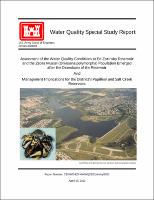Please use this identifier to cite or link to this item:
https://hdl.handle.net/11681/48310| Title: | Water Quality Special Study Report : Assessment of the Water Quality Conditions at Ed Zorinsky Reservoir and the Zebra Mussel (Dreissena polymorpha) Population Emerged After the Drawdown of the Reservoir and Management Implications for the District’s Papillion and Salt Creek Reservoirs |
| Authors: | United States. Army. Corps of Engineers. Omaha District |
| Keywords: | Water quality--Testing Zebra mussel Salt Creek (Neb.) Papillion Creek (Neb.) Lake Zorinsky (Neb.) Environmental management Environmental protection |
| Publisher: | United States. Army. Corps of Engineers. Omaha District. |
| Abstract: | The District has monitored ambient water quality conditions at Zorinsky Lake since the reservoir was initially filled in the early 1990’s, and currently monitors water quality at Zorinsky Lake as part of an Interagency/Support Agreement with the Nebraska Department of Environmental Quality (NDEQ). When the Papillion Creek Tributary projects were authorized water quality management was identified as a concern within the Papillion Creek basin. At that time, studies by the Federal Water Pollution Control Administration (FWPCA) indicated that a need existed for water quality storage within the basin. The FWPCA identified the need for 3 cfs water quality flow in the Big Papillion Creek, Little Papillion Creek, and West Branch Papillion Creek. To meet this need, a water quality component was identified in the multipurpose pool for three of the Papillion Creek Tributary projects (i.e., Ed Zorinsky, Glenn Cunningham, and Wehrspann). Each of these three reservoirs was equipped with a mid-level and low-level outlet to facilitate releases for water quality management. Originally, Zorinsky Lake was to have a multipurpose pool of 4,700 ac-ft with a water quality component of 620 ac-ft. The 1984 survey of Ed Zorinsky Reservoir established the “as-built” multipurpose storage of the reservoir at 3,037 ac-ft. To date, releases for downstream water quality management have not been necessary because seepage, releases, and/or tributary inflows have provided adequate flow for water quality purposes. Since authorized water quality storage has not been required for downstream water quality management, it is available for reservoir water quality management. Zorinsky Lake is dimictic and the near-bottom area of the reservoir becomes anoxic during the summer and winter. Releases could be made from the reservoir through the low-level outlet to discharge poor quality water during these times and replace it with better quality inflow water. Such releases could also promote mixing within the reservoir and possibly improve dissolved oxygen conditions in lower depths when the reservoir is thermally stratified and reduce internal phosphorus loading. |
| Description: | Technical Report |
| Rights: | Approved for Public Release; Distribution is Unlimited |
| URI: | https://hdl.handle.net/11681/48310 |
| Appears in Collections: | Technical Reports |
Files in This Item:
| File | Description | Size | Format | |
|---|---|---|---|---|
| Water Quality Special Study Report - Water Quality Conditions at Ed Zorinsky Reservoir and the Zebra Mussel Emergence after Drawdown_2012.pdf | 12.11 MB | Adobe PDF |  View/Open |